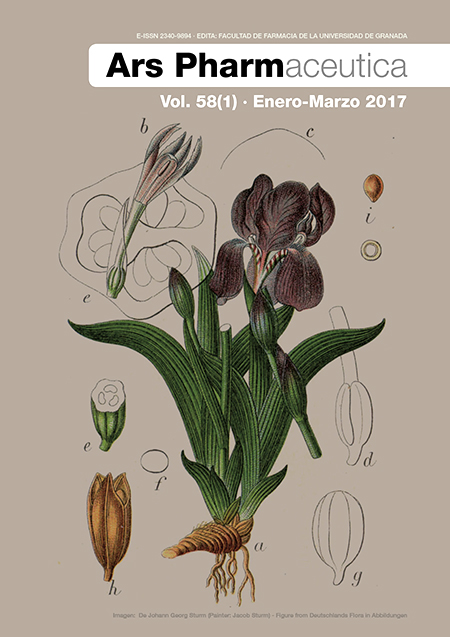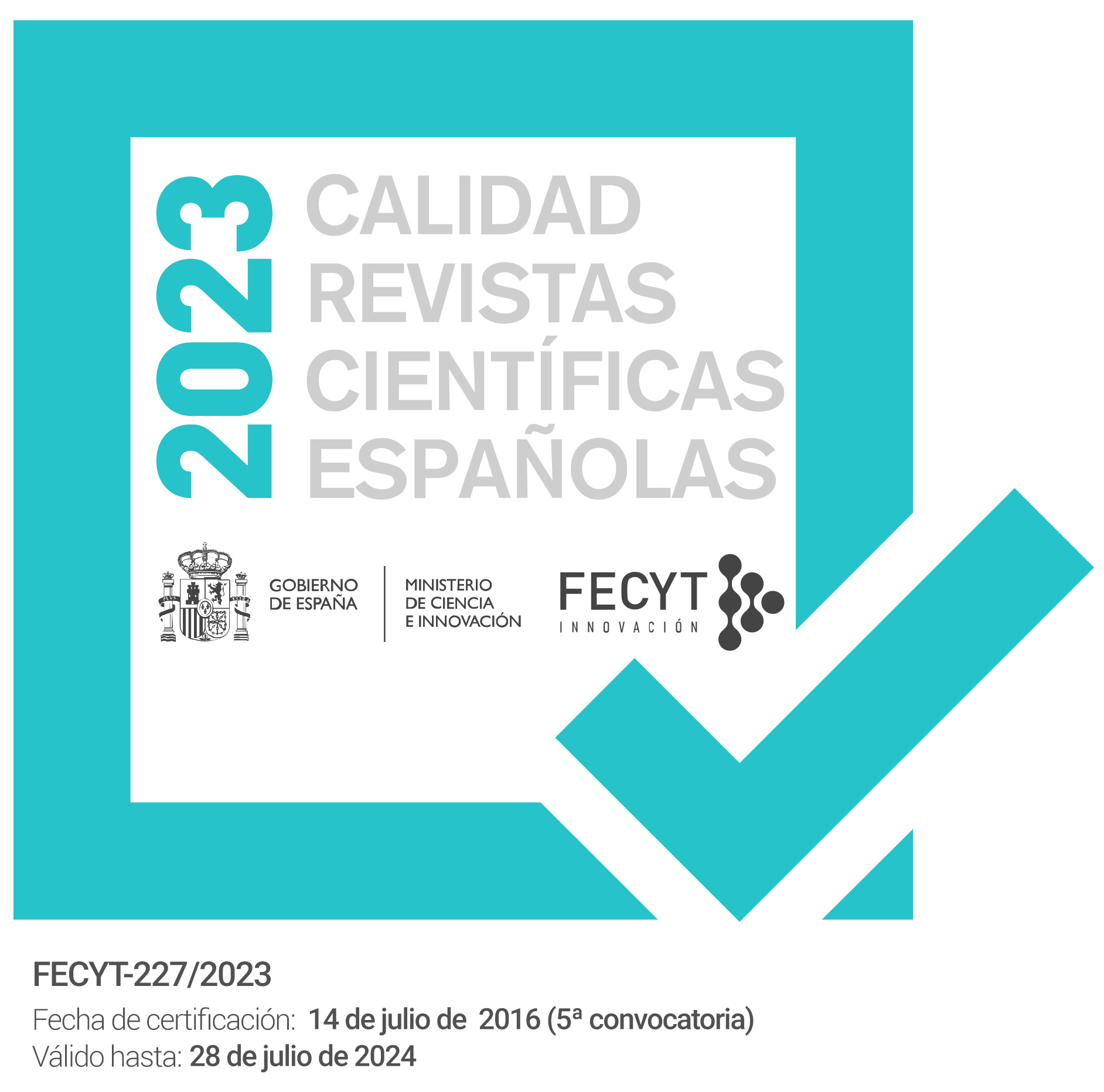Isoflavonoids from the rhizomes of Iris hungarica and antibacterial activity of the dry rhizomes extract
DOI:
https://doi.org/10.30827/ars.v58i1.5919Palabras clave:
isoflavonoides, teсtorigenina, tectoridina, mangiferina, Iris hungarica, actividad antibacterianaResumen
Objetivo: El objetivo del trabajo es el aislamiento y la identificación de los compuestos fenólicos de losrizomas de Iris hungarica.
Materiales y métodos: Se utilizaron métodos químicos y espectrales para conocer las estructuras de compuestosfenólicos que se aislaron de los rizomas de Iris hungarica Waldst. et Kit. (Familia de Iridaceae).Los compuestos se obtuvieron mediante cromatografía en columna sobre gel de sílice y se determinaronsus estructuras mediante análisis de sus espectros por UV, IR, MS, 1H-RMN. Se determinó el cribadopreliminar de la actividad antibacteriana.
Resultados: Se aislaron por primera vez de los rizomas de Iris hungarica (común en Ucrania)dos isoflavonas, teсtorigenina y tectoridina (nuevas para esta especie), el xantonoidemangiferina y los isoflavonoides daidzeina, genisteina y formononetina.El extracto seco de los rizomas de I. hungarica a una concentración de 1% ha mostrado la actividad inhibitoriamás alta para bacterias y hongos Gram-positivos.
Descargas
Citas
Goldblatt P, Manning JC. The Iris family: natural history and classification. Portland: Timber Press; 2008. 336 p.
Marinescu VM, Alexiu V. Iris aphylla L. ssp. hungarica critically endangered taxon in Europa. Current Trends in Natural Sciences. 2013; 2(3): 96-99.
Wróblewska A, Brzosko E. The genetic structure of the steppe plant Iris aphylla L. at the northern limit of its geographical range. Botanical J of the Linnean Society. 2006; 152: 245-255.
Mosyakin SL, Fedoranchuk MM. Vascular plants of Ukraine. A nomenclatural checklist. Kiev; 1999. p. 31-33.
Karpenko VP. Introduction history of species and varieties of genus Iris L. in Ukraine against the background of global trends. Umans’kiy National’nyi Universytet sadivnytstva visnyk. 2015; 2: 85-91.
Tsukasa T, Ootani S. Flavonoids of the genus Iris; structures, distribution and function: review. Ann. Tsukuba Bot. Gard. 1998; 17: 147-183.
Wang H, Cui Y, Zhao C. Flavonoids of the genus Iris (Iridaceae). Mini Rev. Med. Chem. 2010; 10(7): 643-661.
Kukula-Koch W, Sieniawska E, Widelski J, Urjin O, Głowniak P, SkalickaWozniak K. Major secondary metabolites of Iris spp. Phytochem Rev. 2013; 12(4): 1-32.
Rahman AU, Choudhary MI, Alam MN, Ndognii PO, Badarchiin T, Purevsuren G. Two new quinones from Iris bungei. Chem Pharm Bull (Tokyo). 2000; 48(5): 738-739.
Kovalev VN, Mikhailenko OA, Vinogradov BA. Aromatic compounds and terpenoids of Iris hungarica. Chemistry of natural compounds. 2014; 50:161-162.
Khare CP. Indian medicinal plants. Berlin, Heidelberg: Springer-Verlag; 2007. 836 p.
Roger B, Jeannot V, Fernandez X, Cerantola S, Chahboun J. Characterisation and quantification of flavonoids in Iris germanica L. and Iris pallida Lam. resinoids from Morocco. Phytochem anal. 2012; 23(5): 450-455.
Lawless J. The illustrated encyclopedia of essential oils. Publ. Element Books Ltd., Reissue edition; 1995. 256 p.
Adams M, Berset C, Kessler H. Medicinal herbs for the treatment of rheumatic disorders – a survey of European herbals from the 16th and 17th century, J. of Ethnopharmacology. 2009; 121: 343-359.
Zhou J, Xie G, Yan X. Encyclopedia of traditional Chinese medicines: molecular structures, pharmacological activities, natural sources and applications. Vol. 3: isolated compounds H-M. Berlin; Heidelberg; New York: Springer; 2011. 669 p.
Zhou J, Xie G, Yan X. Encyclopedia of traditional Chinese medicines. Molecular structures, pharmacological activities, natural sources and applications. Vol. 5: isolated compounds T-Z. Berlin; Heidelberg; New York: Springer; 2011. 601 р.
Nadaroğlu H, Demir Y, Demir N. Antioxidant and radical scavenging properties of Iris germanica. Pharmaceutical Chemistry Journal. 2007; 41(8): 409-415.
Wollenweber E, Stevens JF, Klimo K. Cancer chemopreventive in vitro activities of isoflavones from Iris germanica. Planta Med. 2003; 69: 15-20.
State Pharmacopoeia of Ukraine. 1st ed. State Enterprise: Scientific and Expert Pharmacopoeial Centre. Kharkov; 2001. (In Ukrainian)
State Pharmacopoeia of Ukraine. 2st ed. Ap. 2. State Enterprise: Scientific and Expert Pharmacopoeial Centre. Kharkiv; 2014. (in Ukrainian)
Korulgin DY, Abilov DA, Muzychkina RA, Tolstikov GA. Natural flavonoids. Novosibirsk: Geo; 2007. 229 p. (In Russian)
Andersen OM, Markham KR. Flavonoids: chemistry, biochemistry and applications. 1st Ed. CRC Press; 2005. 1256 p.
Performance standards for antimicrobial susceptibility testing; twenty-second informational supplements. Clinical and laboratory standards institute. Document M100-S22. CLSI, Wayne, PA. 2012; 32(3): 188 p.
Coyle MB. Manual of antimicrobial susceptibility testing. American Society for Microbiology: Washington; 2005. 236 p.
McFarland J. The nephelometer: an instrument for estimating the number of bacteria in suspensions used for calculating the opsonic index and for vaccines. J Am Med Assoc. 1907; 49(14): 1176-1178.
Jung SH, Lee YS, Lee S, et al. Anti-angiogenic and anti-tumor activities of isoflavonoids from the rhizomes of Belamcanda chinensis. Planta Medica. 2003; 69(7): 617-622.
Joung DK, Mun SH, Lee KS, et al. The antibacterial assay of tectorigenin with detergents or atpase inhibitors against Methicillin-resistant Staphylococcus aureus. Evid. Based Complement Alternat Med. 2014; 2014: 1-7.
Han T, Cheng G, Liu Y, Yang H, Hu YT, Huang W. In vitro evaluation of tectoridin, tectorigenin and tectorigenin sodium sulfonate on antioxidant properties. Food Chem Toxicol. 2012; 50(2): 409-414.
Qin J, Deng J, Feng X, Wang Q, Wang S. Quantitative RP–LC analysis of mangiferin and homomangiferin in Mangifera indica L. leaves and in Mangifera persiciforma C.Y. Wu et T.L. Ming leaves. Chromatographia. 2008; 68(11/12): 955-960.
Waridel P, Wolfender JL, Ndjoko K, Hobby KR, Major HJ, Hostettmann K. Evaluation of quadrupole time-of-flight tandem mass spectrometry and ion-trap multiple-stage mass spectrometry for the differentiation of C-glycosidic flavonoid isomers. J. Chromatogr. A. 2001; 926: 29-41.
Saha S, Sadhukhan P, Sil PC. Mangiferin: a xanthonoid with multipotent anti-inflammatory potential. Biofactors. 2016; 42(5): 459-474.
Descargas
Publicado
Cómo citar
Número
Sección
Licencia
Los artículos que se publican en esta revista están sujetos a los siguientes términos en relación a los derechos patrimoniales o de explotación:
- Los autores/as conservarán sus derechos de autor y garantizarán a la revista el derecho de primera publicación de su obra, la cual se distribuirá con una licencia Creative Commons BY-NC-SA 4.0 que permite a terceros reutilizar la obra siempre que se indique su autor, se cite la fuente original y no se haga un uso comercial de la misma.
- Los autores/as podrán adoptar otros acuerdos de licencia no exclusiva de distribución de la versión de la obra publicada (p. ej.: depositarla en un archivo telemático institucional o publicarla en un volumen monográfico) siempre que se indique la fuente original de su publicación.
- Se permite y recomienda a los autores/as difundir su obra a través de Internet (p. ej.: en repositorios institucionales o en su página web) antes y durante el proceso de envío, lo cual puede producir intercambios interesantes y aumentar las citas de la obra publicada. (Véase El efecto del acceso abierto).
























